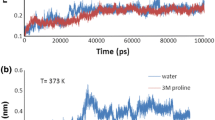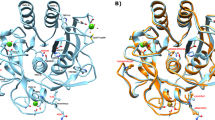Abstract
Charged amino acids having ionizable side chains play crucial roles in maintaining the solubility and stability of a protein. These charged amino acids are mostly exposed on protein surface and participate in electrostatic interactions with neighboring charged amino acids as well as with solvent. Therefore, the change in the solvent pH affects the protein stability in most cases. Previously, we reported a GFP variant, GFP14R having 14 surface lysines replaced with arginines, that showed enhanced stability under alkaline pH. Here, we analyzed the factors that contribute to the stability of the GFP14R under alkaline pH quantitatively using molecular dynamics simulations. Protonation state of the charged amino acids of GFP14R and control GFP under neutral pH and alkaline pH were modeled, and molecular dynamics simulations were performed. This comparative analysis revealed that the GFP14R with more arginine frequency on the surface maintained the stability under both pH conditions without much change in their salt-bridge interactions as well as the hydrogen bond interactions with solvent. On the other hand, these interactions were significantly reduced for the control GFP under alkaline pH due to the deprotonated lysine side chains. These results suggest that the advantageous property of arginine over lysine can be considered one of the parameter for the protein stability engineering under alkaline pH conditions.
Similar content being viewed by others
References
Pace, C. N., G. R. Grimsley, and J. M. Scholtz (2009) Protein ionizable groups: pK values and their contribution to protein stability and solubility. J. Biol. Chem. 284: 13285–13289.
Trevino, S. R., J. M. Scholtz, and C. N. Pace (2007) Amino acid contribution to protein solubility: Asp, Glu, and Ser contribute more favorably than the other hydrophilic amino acids in RNase Sa. J. Mol. Biol. 366: 449–460.
Pace, C. N., D. V. Laurents, and J. A. Thomson (1990) pH dependence of the urea and guanidine hydrochloride denaturation of ribonuclease A and ribonuclease T1. Biochem. 29: 2564–2572.
Schweiker, K. L., A. Zarrine-Afsar, A. R. Davidson, and G. I. Makhatadze (2007) Computational design of the Fyn SH3 domain with increased stability through optimization of surface charge charge interactions. Protein Sci. 16: 2694–2702.
Saeki, K., K. Ozaki, T. Kobayashi, and S. Ito (2007) Detergent alkaline proteases: Enzymatic properties, genes, and crystal structures. J. Biosci. Bioeng. 103: 501–508.
Kumar, C. G. and H. Takagi (1999) Microbial alkaline proteases: From a bioindustrial viewpoint. Biotechnol. Adv. 17: 561–594.
Gulich, S., M. Linhult, S. Stahl, and S. Hober (2002) Engineering streptococcal protein G for increased alkaline stability. Protein Eng. 15: 835–842.
Asplund, M., M. Ramberg, and B. -L. Johansson (2000) Development of a cleaning in place protocol and repetitive application of Escherichia coli homogenate on STREAMLINE™ Q XL. Proc. Biochem. 35: 1111–1118.
Cunningham, B. C. and J. A. Wells (1987) Improvement in the alkaline stability of subtilisin using an efficient random mutagenesis and screening procedure. Protein Eng. 1: 319–325.
Sokalingam, S., G. Raghunathan, N. Soundrarajan, and S. -G. Lee (2012) A study on the effect of surface lysine to arginine mutagenesis on protein stability and structure using green fluorescent protein. PLoS One. 7: e40410.
Hess, B., C. Kutzner, D. van der Spoel, and E. Lindahl (2008) GROMACS 4: Algorithms for highly efficient, load-balanced, and scalable molecular simulation. J. Chem. Theory Comput. 4: 435–447.
P.Cormack, B., R. H. Valdivia, and S. Falkow (1996) FACS-optimized mutants of the green fluorescent protein (GFP). Gene 173: 33–38.
Huang, J. -R., S. -T. D. Hsu, J. Christodoulou, and S. E. Jackson (2008) The extremely slow-exchanging core and acid-denatured state of green fluorescent protein. HFSP J. 2: 378–387.
Yang, F., L. G. Moss, and G. N. Phillips (1996) The molecular structure of green fluorescent protein. Nat. Biotechnol. 14: 1246–1251.
Petukhov, M., D. Cregut, C. M. Soares, and L. Serrano (1999) Local water bridges and protein conformational stability. Protein Sci. 8: 1982–1989.
Mattos, C. (2002) Protein-water interactions in a dynamic world. Trends Biochem. Sci. 27: 203–208.
Steinbach, P. J. and B. R. Brooks (1993) Protein hydration elucidated by molecular dynamics simulation. Proc. Natl. Acad. Sci. U.S.A. 90: 9135–9139.
Lau, E. Y., J. L. Phillips, and M. E. Colvin (2009) Molecular dynamics simulations of highly charged green fluorescent proteins. Mol. Phys. 107: 1233–1241.
Matysiak, S., P. G. Debenedetti, and P. J. Rossky (2012) Role of hydrophobic hydration in protein stability: A 3D water-explicit protein model exhibiting cold and heat denaturation. J. Phys. Chem. B. 116: 8095–8104.
Chakraborty, S. and S. Bandyopadhyay (2007) Correlation between the dynamics of hydrogen bonds and the local density reorganization in the protein hydration layer. J. Phys. Chem. B. 111: 7626–7630.
Kuffel, A. and J. Zielkiewicz (2012) The importance of the shape of the protein-water interface of a kinesin motor domain for dynamics of the surface atoms of the protein. Phys. Chem. Chem. Phys. 14: 5561–5569.
Adrover, M., G. Martorell, S. R. Martin, D. Urosev, P. V. Konarev, D. I. Svergun, X. Daura, P. Temussi, and A. Pastore (2012) The role of hydration in protein stability: Comparison of the cold and heat unfolded states of Yfh1. J. Mol. Biol. 417: 413–424.
Author information
Authors and Affiliations
Corresponding author
Rights and permissions
About this article
Cite this article
Sokalingam, S., Madan, B., Raghunathan, G. et al. Deciphering the factors responsible for the stability of a GFP variant resistant to alkaline pH using molecular dynamics simulations. Biotechnol Bioproc E 18, 858–867 (2013). https://doi.org/10.1007/s12257-013-0309-1
Received:
Accepted:
Published:
Issue Date:
DOI: https://doi.org/10.1007/s12257-013-0309-1




